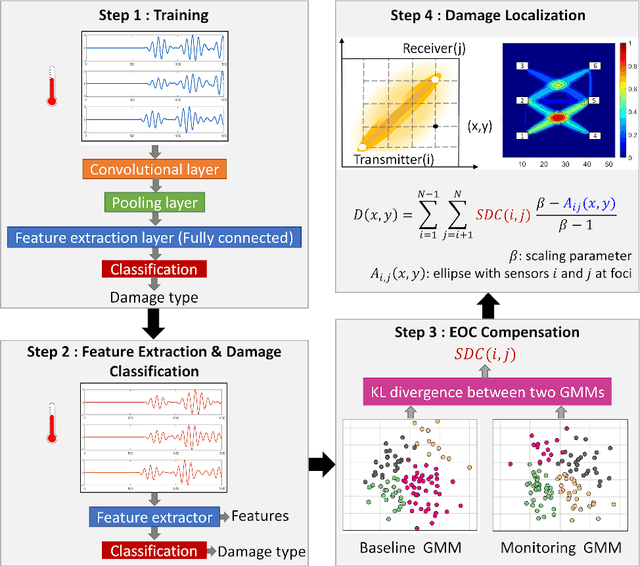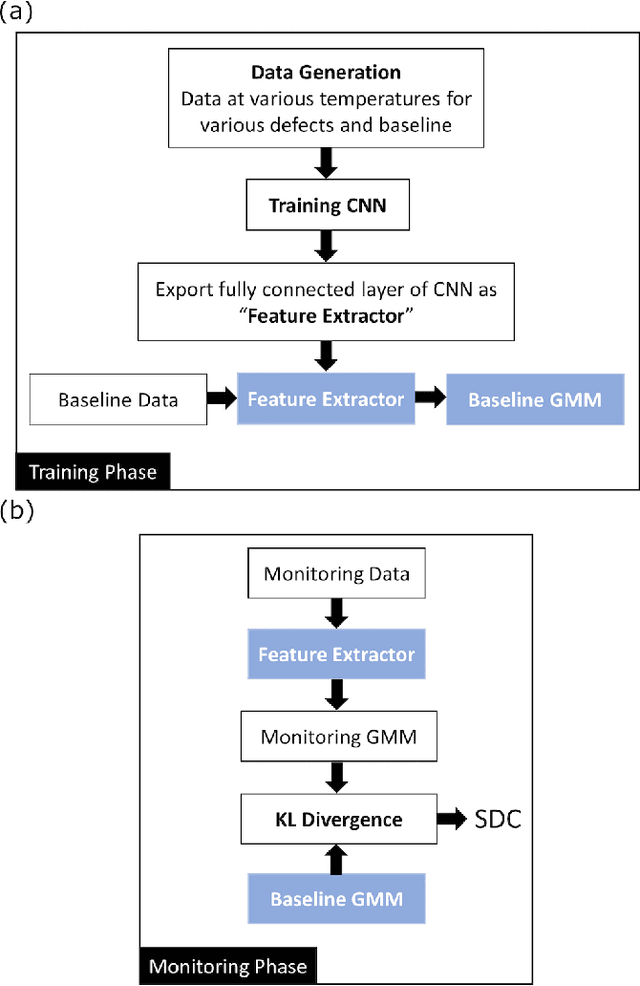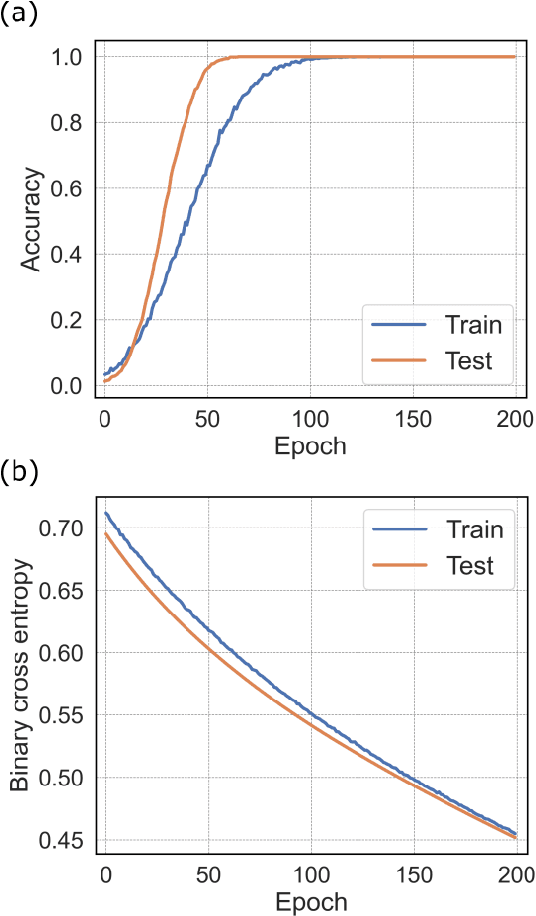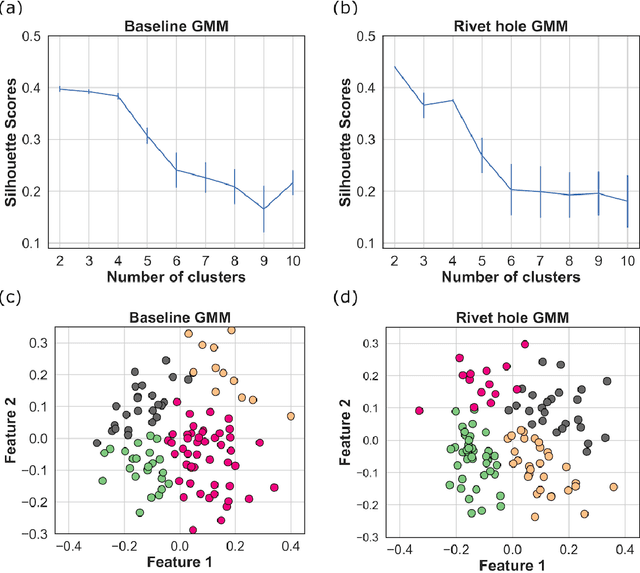Sheetal Patil
Smart structural health monitoring (SHM) system for on-board localization of defects in pipes using torsional ultrasonic guided waves
Mar 17, 2024Abstract:Most reported research for monitoring health of pipelines using ultrasonic guided waves (GW) typically utilize bulky piezoelectric transducer rings and laboratory-grade ultrasonic non-destructive testing (NDT) equipment. Consequently, the translation of these approaches from laboratory settings to field-deployable systems for real-time structural health monitoring (SHM) becomes challenging. In this work, we present an innovative algorithm for damage identification and localization in pipes, implemented on a compact FPGA-based smart GW-SHM system. The custom-designed board, featuring a Xilinx Artix-7 FPGA and front-end electronics, is capable of actuating the PZT thickness shear mode transducers, data acquisition and recording from PZT sensors and generating a damage index (DI) map for localizing the damage on the structure. The algorithm is a variation of the common source method adapted for cylindrical geometry. The utility of the algorithm is demonstrated for detection and localization of defects such as notch and mass loading on a steel pipe, through extensive finite element (FE) method simulations. Experimental results obtained using a C-clamp for applying mass loading on the pipe show good agreement with the FE simulations. The localization error values for experimental data analyzed using C code on a processor implemented on the FPGA are consistent with algorithm results generated on a computer running MATLAB code. The system presented in this study is suitable for a wide range of GW-SHM applications, especially in cost-sensitive scenarios that benefit from on-node signal processing over cloud-based solutions.
BrainVoxGen: Deep learning framework for synthesis of Ultrasound to MRI
Oct 11, 2023



Abstract:The study presents a deep learning framework aimed at synthesizing 3D MRI volumes from three-dimensional ultrasound images of the brain utilizing the Pix2Pix GAN model. The process involves inputting a 3D volume of ultrasounds into a UNET generator and patch discriminator, generating a corresponding 3D volume of MRI. Model performance was evaluated using losses on the discriminator and generator applied to a dataset of 3D ultrasound and MRI images. The results indicate that the synthesized MRI images exhibit some similarity to the expected outcomes. Despite challenges related to dataset size, computational resources, and technical complexities, the method successfully generated MRI volume with a satisfactory similarity score meant to serve as a baseline for further research. It underscores the potential of deep learning-based volume synthesis techniques for ultrasound to MRI conversion, showcasing their viability for medical applications. Further refinement and exploration are warranted for enhanced clinical relevance.
Unsupervised deep learning framework for temperature-compensated damage assessment using ultrasonic guided waves on edge device
Oct 08, 2023Abstract:Fueled by the rapid development of machine learning (ML) and greater access to cloud computing and graphics processing units (GPUs), various deep learning based models have been proposed for improving performance of ultrasonic guided wave structural health monitoring (GW-SHM) systems, especially to counter complexity and heterogeneity in data due to varying environmental factors (e.g., temperature) and types of damages. Such models typically comprise of millions of trainable parameters, and therefore add to cost of deployment due to requirements of cloud connectivity and processing, thus limiting the scale of deployment of GW-SHM. In this work, we propose an alternative solution that leverages TinyML framework for development of light-weight ML models that could be directly deployed on embedded edge devices. The utility of our solution is illustrated by presenting an unsupervised learning framework for damage detection in honeycomb composite sandwich structure (HCSS) with disbond and delamination type of damages, validated using data generated by finite element (FE) simulations and experiments performed at various temperatures in the range 0{\deg}C to 90{\deg}C. We demonstrate a fully-integrated solution using a Xilinx Artix-7 FPGA for data acquisition and control, and edge-inference of damage.
Systematic Review of Techniques in Brain Image Synthesis using Deep Learning
Sep 08, 2023



Abstract:This review paper delves into the present state of medical imaging, with a specific focus on the use of deep learning techniques for brain image synthesis. The need for medical image synthesis to improve diagnostic accuracy and decrease invasiveness in medical procedures is emphasized, along with the role of deep learning in enabling these advancements. The paper examines various methods and techniques for brain image synthesis, including 2D to 3D constructions, MRI synthesis, and the use of transformers. It also addresses limitations and challenges faced in these methods, such as obtaining well-curated training data and addressing brain ultrasound issues. The review concludes by exploring the future potential of this field and the opportunities for further advancements in medical imaging using deep learning techniques. The significance of transformers and their potential to revolutionize the medical imaging field is highlighted. Additionally, the paper discusses the potential solutions to the shortcomings and limitations faced in this field. The review provides researchers with an updated reference on the present state of the field and aims to inspire further research and bridge the gap between the present state of medical imaging and the future possibilities offered by deep learning techniques.
Environmental variation compensated damage classification and localization in ultrasonic guided wave SHM using self-learnt features and Gaussian mixture models
Nov 11, 2021



Abstract:Conventional damage localization algorithms used in ultrasonic guided wave-based structural health monitoring (GW-SHM) rely on physics-defined features of GW signals. In addition to requiring domain knowledge of the interaction of various GW modes with various types of damages, they also suffer from errors due to variations in environmental and operating conditions (EOCs) in practical use cases. While several machine learning tools have been reported for EOC compensation, they need to be custom-designed for each combination of damage and structure due to their dependence on physics-defined feature extraction. In this work, we propose a CNN-based automated feature extraction framework coupled with Gaussian mixture model (GMM) based EOC compensation and damage classification and localization method. Features learnt by the CNNs are used for damage classification and localization of damage by modeling the probability distribution of the features using GMMs. The Kullback-Leibler (KL) divergence of these GMMs with respect to corresponding baseline GMMs are used as signal difference coefficients (SDCs) to compute damage indices (DIs) along various GW sensor paths, and thus for damage localization. The efficacy of the proposed method is demonstrated using FE generated GW-data for an aluminum plate with a network of six lead zirconate titanate (PZT) sensors, for three different types of damages (rivet hole, added mass, notch) at various temperatures, with added white noise and pink noise to incorporate errors due to EOCs. We also present experimental validation of the method through characterization of notch damage in an aluminum panel under varying and non-uniform temperature profiles, using a portable custom-designed field programmable gate array (FPGA) based signal transduction and data acquisition system.
 Add to Chrome
Add to Chrome Add to Firefox
Add to Firefox Add to Edge
Add to Edge